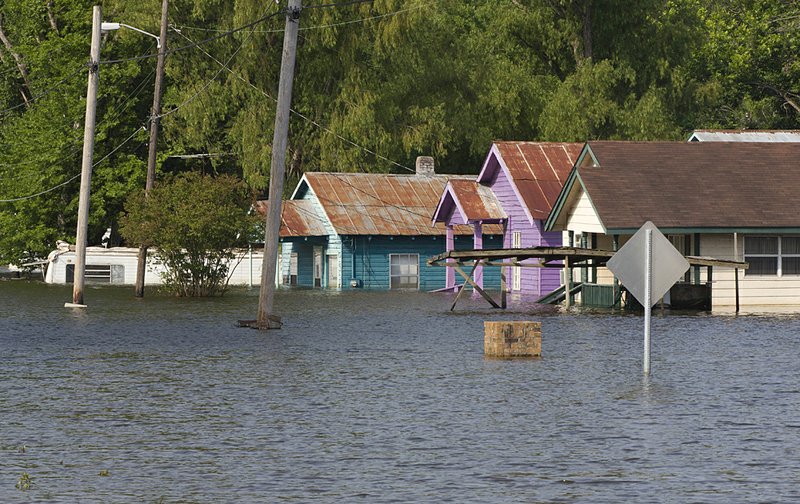JACKSON, Miss. — The Mississippi River’s fall is coming in baby steps, not leaps or bounds, and officials, residents and businesses all along the river are reacting at the same pace.
Galleries & Videos:
Recent flood stories & info:
In Greenville, Miss., the local port expects to be out of operation until sometime in June.
“We’re still under water,” said Port of Greenville Director Tommy Hart. “We have to wait until the water goes down below the dock, and then when it does, we’ll have to worry about cleaning up. We can’t put the equipment that we moved out before the area is clean. I’m not worried about the debris so much as I am about the sediment. That will probably be about an inch deep and it’s going to take some time to clean that up.”
Hart said the port has been closed since May 2.
As rain fell across Arkansas Sunday, flooding fears were taking a back seat to cleanup concerns.
“I think it will halt cleanup a lot. It doesn’t have to be dry, but it doesn’t have to be heavy rain falling down,” Prairie County Judge Mike Skarda said. “[The rain] shouldn’t have a great effect on us other than just being nasty cleanup.”
Peter Nimrod, chief engineer of the Board of Mississippi Levee Commissioners, said the river is expected to drop to 59.4 feet by Wednesday.
He said there have been 12 areas that have experienced sand boils along the 212-mile stretch of the levee.
“You don’t want it to drop too fast because that may form levee slides, and we don’t want that,” he said.
At Eagle Lake, north of Vicksburg, Miss., the usually bustling community of water-loving recreation seekers has dwindled to a ghost town. Boat ramps normally edged with trucks and trailers are vacant. Power has been shut off since Thursday.
It did not bother Tim Stennett, who has remained in his home with his wife, Sheryl.
“We prepared for two weeks without electricity and [have] the ability to boat out if need be,” Stennett said.
On April 30, gates on the Muddy Bayou Control Structure were opened to relieve pressure on the Buck Chute Levee and filled Eagle Lake to 90 feet from its ideal level of 76.9 feet.
Chris Libbey said that raising the lake put most boathouses and piers under several feet of water but did not affect most of the homes and cabins.
About 15 people stayed in their Eagle Lake homes. Most of them get together every evening to cook and chat, mostly about the flooding.
Will Hubert is one of the residents intent on staying in the town where he has lived his entire life. Hubert, 46, has taken precautions. He now carries a life jacket in his truck and knows where the high ground is.
In Arkansas, Sunday’s storm system, which originated from a cold front west of the state, affected areas along the I-40 corridor, including Cabot, Helena-West Helena, Des Arc and Forrest City, said Emilie Nipper, a meteorologist with the National Weather Service office in North Little Rock.
Rainfall Saturday night and Sunday was concentrated in a line from Hot Springs to LittleRock, National Weather Service meteorologist Joe Goudsward said.
In a 24-hour period ending at 7 p.m. Sunday, Hot Springs received 1.45 inches of rain and Little Rock received 1.36 inches, Goudsward said. North Little Rock and Pine Bluff received a half-inch each, and Mount Ida and West Memphis each received one-third of an inch.
No rain was recorded during the period at measuring stations in Fayetteville, Harrison, Mountain Home, Monticello, De Queen and Blytheville.
The storms are expected to last through Thursday.
Nipper said a tornado that touched down 2.7 miles southwest of Malvern on Friday and caused minor damage was an EF0 tornado, the lowest rating on the Enhanced Fujita Scale of Tornado Intensity. According to the weather service, EF0 tornados can produce winds from 65 to 85 mph.
Arkansas Department of Emergency Management spokesman Tommy Jackson said no damage reports had come in Sunday afternoon from the day’s storms.
Skarda said that in Des Arc, an area where more than 120 homes on the outskirts of the city have been completely destroyed by recent flooding, more rain will add to the emotional devastation.
Desha County Judge Mark McElroy said his county felt safe despite the rainfall Sunday, but rising rivers may become a threat.
“It’s kind of like putting a 5-gallon bucket of water in the sink in your kitchen ... all that water from Missouri and Kansas has to come through us down here,” McElroy said. “We’re hoping our neighbors get the rain they need, use it and don’t send us any more.”
The Army Corps of Engineers-Little Rock District reissued a small-craft advisory for the Arkansas River on Saturday, with the strongest flows at Trimble Lock and Dam at Fort Smith, with 100,000 cubic feet per second, spokesman Laurie Driver said. Driver said flows at the Murray Lock and Dam at Little Rock were 85,000 cubic feet per second Saturday.
With more than 700 homes and other structures still underwater, Monroe County Sheriff Gary Henard said communities in the southern part of the county, such as Indian Bay, are reachable only by boat.
County Judge Larry Morris said as of Friday, only 179 county residents affected by the flooding had pre-registered with the Federal Emergency Management Agency for disaster relief funds.
Morris said the county has 8,149 residents.
Information for this article was contributed by Aprille Hanson and Andy Davis of the Arkansas Democrat-Gazette, by the Delta Democrat Times in Greenville, by the Vicksburg Post, and by The Natchez Democrat.
Front Section, Pages 3 on 05/23/2011
